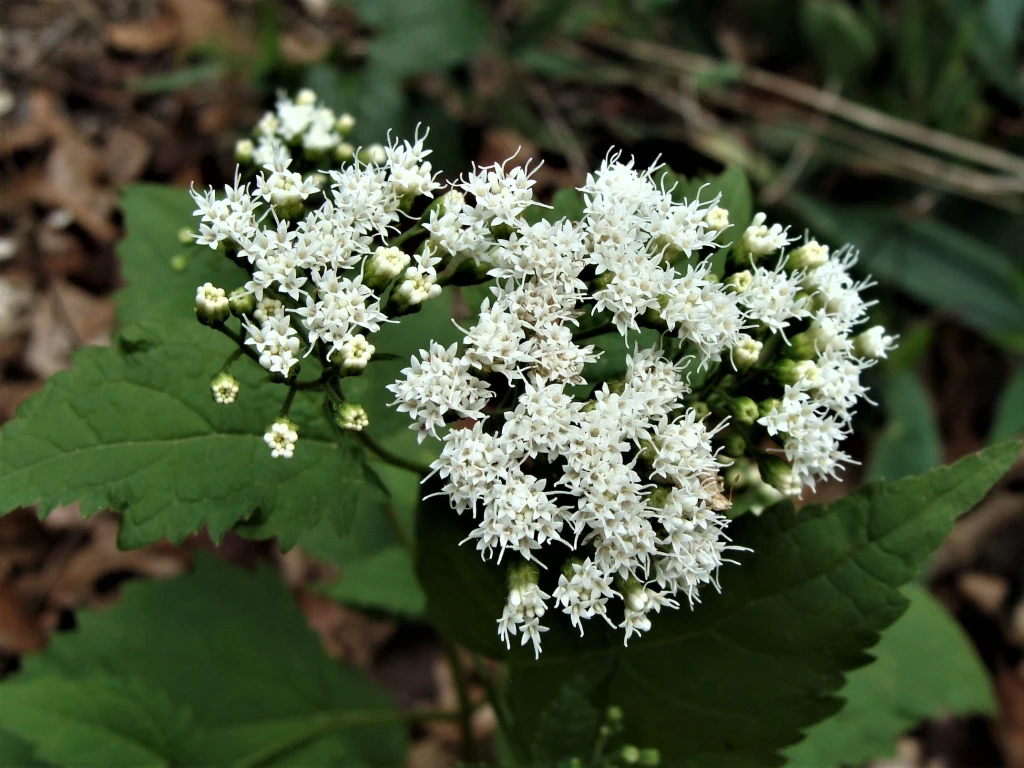White snakeroot (Ageratina altissima*), formerly Eupatorium rugosum, of the Aster, Sunflower, or Composite (Asteraceae ) family has a multitude of small white flowerheads late in the growing season. It occurs from Texas to eastern North Dakota, across all states to the Atlantic and Gulf Coasts, but of limited occurrence in Florida and Georgia. In Arkansas, white snakeroot, the only species of Ageratina in the state, occurs statewide. The genus name (originating from “ageratum”) is based on Greek words for “unaging”, in reference to the long-lasting color of the inflorescence. The specific epithet means “tallest”, in comparison with other species of the genus. The common name relates to use of the roots by Native Americans for treating snake bites. Habitat preference is mesic, fertile soils in riparian to upland deciduous woodlands and woodland edges and thickets. Plants are poisonous.**
White snakeroot, a perennial herbaceous plant, may have a single, foot-tall stem or several stems to 3+ feet tall. Plants are mostly glabrous (hairless), with minute pubescence near the inflorescence. Stems have well-spaced, opposite, decussate leaves with slender petioles with widened bases. Between the widened petiole bases of paired opposite leaves, an “edge” connects the bases resulting in prominent nodes along larger stems. The root system consists of small basal caudices with a mass of long-radiating, near-surface, wiry roots.


Axillary branching occurs in the upper portion of plants. While shorter plants with few branches remain erect without support, larger plants that have numerous branches in their upper portion tend to lean or recline when lacking support. Stems and branches, mostly in opposite pairs, are ascending and rigid with branches rising from stems at about 45 degrees. Branches may be 16 inches long with sub-branches at their upper portion that may be 8 inches long. Overall, stems and branches are yellowish green, with lower stems and branches transitioning to reddish brown and becoming hardened. Larger stems have pith-filled centers. With heavy seed production, thick stands may develop in preferred habitats.

Leaves are ovate-lanceolate, to 6 inches long, becoming lanceolate and decreasing in length above. Blade margins are sharply serrate.

White snakeroot blooms in mid-fall. A large plant may have stems that divide into a dozen or more branches, each with sub-branches. The inflorescence consists of “large cymes” (3 to 4 inches across) of composite flower heads. Flowerheads are uniformly distributed across the cymes, creating a rounded inflorescence. Flowering sequence gradually shifts from central cymes to outer cymes.
A colony of white snakeroot in early bloom with its masses of flowers of the purest white is one of the most beautiful sights in the deciduous forest. The flowerheads are composed of 1/4-inch-long, white disk florets set into 1/8-inch-long, elongate, pale green involucres. Involucres comprise a single series of clasping, linear, appressed phyllaries (bracts) with acute apexes. Each flowerhead, to ⅛ inch across, bears 12 to 30 tubular florets with white corollas surrounded by pappus bristles. At anthesis, corollas have 5 flared, acutely triangular lobes. Stamens, a slightly off-white color, form an elongate central anther ring. The style, exerted through the anther ring, presents the pollen, after which its apex divides to expose two long stigmatic surfaces. The stigmatic surfaces are thin and twisty, so that cymes, with all flowerheads facing the sunlight, have a delicate appearance.


Fertilized florets produce narrowly oblong, black achenes (“cypselae” in the Aster family) topped with the radiating bristles of the pappus (morphologically, highly modified sepals). Achenes are ribbed and glabrous. Seed dispersal is by wind.

White snakeroot, retaining a fresh appearance into fall, produces masses of white flowers for a month or more. It can be quite showy in partial to full shade gardens, especially striking if other fall bloomers (goldenrods, asters) are nearby. In a garden setting, plant spreading may need to be controlled by select plant removal and deadheading to prevent aggressive self-seeding. Also, it is a nice plant for naturalized areas. A variety of insects feed on the leaves, nectar and pollen. It is not eaten by deer.

** The entire plant, containing tremetol, is poisonous. When pioneers moved west into the unsettled eastern forest, cattle were often left to graze in open woodlands, ideal habitat for white snakeroot, and people developed “milk sickness” from tainted milk and meat. Thousands died before white snakeroot was identified as the source of the toxin. With current herd and milk production practices, milk sickness is now uncommon.
Article and photographs by ANPS member Sid Vogelpohl

